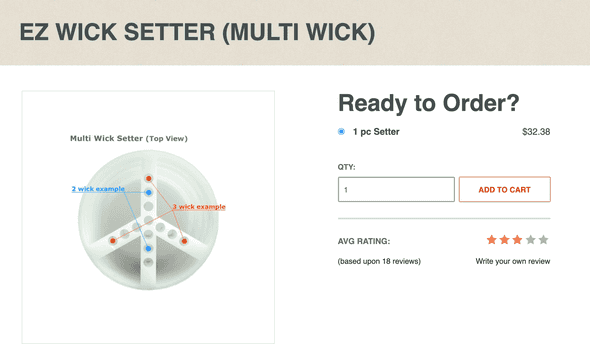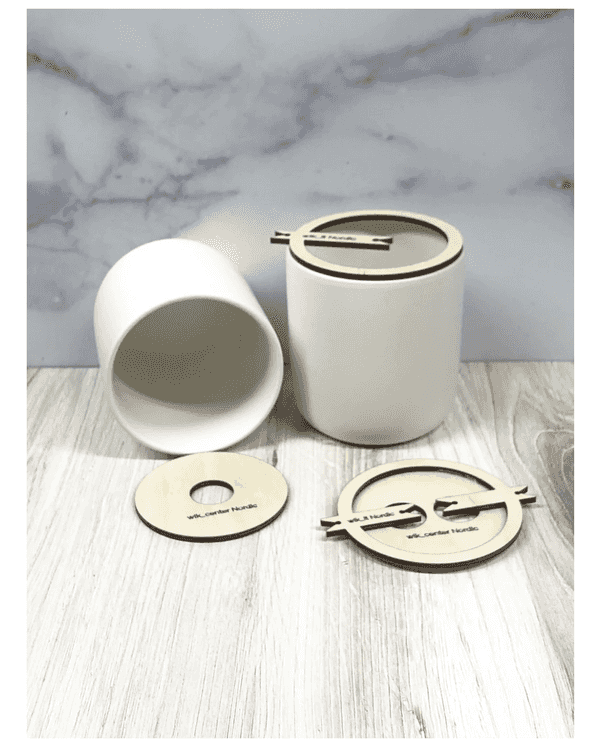How to better center your wicks
March 20, 2021 | 2 minute read
Ever end up accidentally misaligning your wick? I have, and it sucks. The wick becomes impossible to remove (or fix), and the mistake results in a wasted jar.
Some suggest that you can rectify this error by using a wick-holder to help center the top; however, this will still result in an angled wick. Your mistake will surface once the candle gets burned.
What’s the issue with having a non-centered wick?
One is that the candle might not burn evenly, and you’ll risk tunneling. As the flame moves away from the center, one side will receive less heat, and the wax there will not melt, resulting in tunneling.
The second is that you risk pulling the flame closer to the jar. As the flame moves closer to the jar, the entire candle becomes difficult to handle, increasing the chances of an accident happening. Additionally, when the glass comes in close contact with the flame, the glass could burst. The possibility of bursting is why it’s suggested to stop burning the candle when the wick is less than 1/4” long.
Are there tools out there to help me center my wicks?
Yes, there are.
From CandleScience:

It has a range of wick holes to allow for many different wick combinations. However, its reviews indicate that the hardware is not sturdy, isn’t flexible enough for the maker’s requirements, and pricey.
From DzignHaus:

Their wick holders are helpful because they tailor to vessel providers. When you visit their wick-centering product inventory, you’ll notice how they segment their products based on vessel providers. So if you have a candlescience jar, the wick-centering products you’ll need will fall under the candlescience section. This specificity level makes me think that it’s likely that their wick-centering device will undoubtedly work for their targeted jars.
As for the product itself, its design is a lot simpler than Candlescience’s solution. It’s priced to be the same, and each offering provides multiple wick_its and wik_centers. I think wik_its helps you maintain the tension of the wick as you pour the wax in, while wik_centers enables you to center the wick at initial wick-taping.
What I do think is a downside with this product is that it’s not flexible. If you want to double-wick something, you kind of can’t. If you want to try a new jar size, you’d need to buy a new set for your new jar.
If you’ve read this far, I’d like to suggest an alternative. Instead of resorting to a vendor-locked tool, consider creating something of your own with paper.
Jeff Standley has a good video detailing one way to go about using paper for centering wicks. Once you nail down the specifics for one vessel, you can re-apply that blueprint for all other usages of that vessel.
Then there’s me, narrating my solution.
One thing to note in the video, I added the little tape-stick attachment so I could easily pull the circular plane piece of paper back up. The tape-stick attachment also helped me balance the wick as I pushed it down.
Along with the circular plane paper, you’ll still need a clothespin or wick-holder to keep the wick straight. The gadget I demoed will only help when you are setting the wick; it won’t help maintain a straight posture for your wick.
Excuse how simple this printout is. It never dawned on me how what was actually required for “wick-centering”. You just need a way to maintain what the “center” is, and a paper cutout of the bottom of the jar works perfectly.
If there’s interest in printing out blueprints for other vessel types and wick combinations, message me on IG and I’ll look into mocking those up.